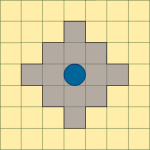Well the whole reach thing breaks down in the fact that creatures with larger than 10 foot reach don't get the extra squares that creatures with 10-foot reach get.ainatan said:Benimoto said:Those corner squares are less than 50% covered, and a 10-foot line doesn't even quite touch the center of the corner squares.
That 50% rule is just for area effects, not reach.
And, on a separate point, for those advocating the 2 movement, 3 diagonal system, you'll notice that for any movement with an even number of movement points, you're really going with something similar to a 2-1-2-1 diagonal system instead of the present 1-2-1-2 system. This creates some weird problems when you try to use the system for things like reach or spell radius.
In fact, using the 2 straight, 3 diagonal system, or any system that penalizes the first diagonal, you'll notice the first weird effect with creatures that have 5 foot reach, like basically everybody. If you consider 5 feet equal to two distance points, a creature with 5 foot reach can't even attack diagonally, since that's three distance points away. You also lose the ability to take a 5-foot step diagonally. I would consider that a weird effect.
And for all the people still complaining about the "diagonal dodge", notice what Shoe said earlier:
He's pretty much confirming that moving and charging in 4th edition works similarly or the same as it works in the DDM rules. That is:DMShoe said:Besides -- the defender who is trying to "defend" by standing in the middle of an open room isn't doing his job very well. Even with 1-2-1, the monster could move out to the side and then charge the wizard. The defender should either be back near the wizard, or basing the monster. Just sayin'.
Move up to your speed = move action
Shift (5 foot step) = move action
Any kind of attack = attack action
Charge (move up to your speed and standard melee attack) = attack action
You can, of course, use your attack action to take a second move action. Charging no longer has to be in a straight line, and isn't stopped by difficult terrain or allies anymore.
So, most of the examples where the creature can only move 30 feet and then attack just don't apply to 4th edition. The range that creatures can attack from dramatically increases, and defenders have to be way more active, engaging threats and pinning them down, than passive. Just standing in the way won't work no matter what movement system you use.



